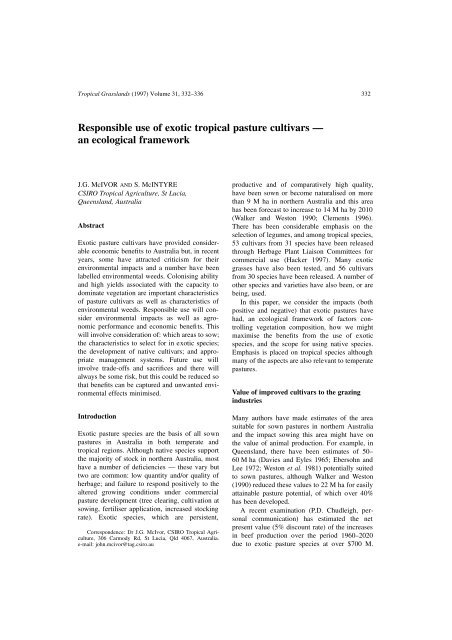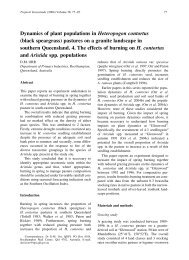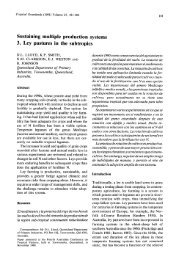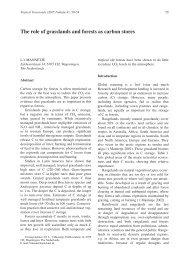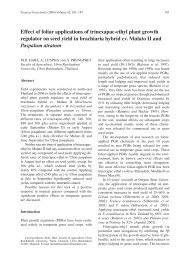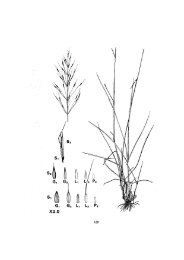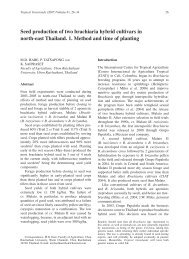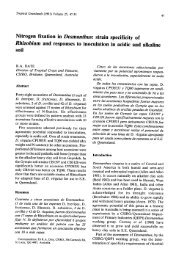Responsible use of exotic tropical pasture cultivars â an ecological ...
Responsible use of exotic tropical pasture cultivars â an ecological ...
Responsible use of exotic tropical pasture cultivars â an ecological ...
Create successful ePaper yourself
Turn your PDF publications into a flip-book with our unique Google optimized e-Paper software.
Tropical Grassl<strong>an</strong>ds (1997) Volume 31, 332–336 332<br />
<strong>Responsible</strong> <strong>use</strong> <strong>of</strong> <strong>exotic</strong> <strong>tropical</strong> <strong>pasture</strong> <strong>cultivars</strong> —<br />
<strong>an</strong> <strong>ecological</strong> framework<br />
J.G. McIVOR AND S. McINTYRE<br />
CSIRO Tropical Agriculture, St Lucia,<br />
Queensl<strong>an</strong>d, Australia<br />
Abstract<br />
Exotic <strong>pasture</strong> <strong>cultivars</strong> have provided considerable<br />
economic benefits to Australia but, in recent<br />
years, some have attracted criticism for their<br />
environmental impacts <strong>an</strong>d a number have been<br />
labelled environmental weeds. Colonising ability<br />
<strong>an</strong>d high yields associated with the capacity to<br />
dominate vegetation are import<strong>an</strong>t characteristics<br />
<strong>of</strong> <strong>pasture</strong> <strong>cultivars</strong> as well as characteristics <strong>of</strong><br />
environmental weeds. <strong>Responsible</strong> <strong>use</strong> will consider<br />
environmental impacts as well as agronomic<br />
perform<strong>an</strong>ce <strong>an</strong>d economic benefits. This<br />
will involve consideration <strong>of</strong>: which areas to sow;<br />
the characteristics to select for in <strong>exotic</strong> species;<br />
the development <strong>of</strong> native <strong>cultivars</strong>; <strong>an</strong>d appropriate<br />
m<strong>an</strong>agement systems. Future <strong>use</strong> will<br />
involve trade-<strong>of</strong>fs <strong>an</strong>d sacrifices <strong>an</strong>d there will<br />
always be some risk, but this could be reduced so<br />
that benefits c<strong>an</strong> be captured <strong>an</strong>d unw<strong>an</strong>ted environmental<br />
effects minimised.<br />
Introduction<br />
Exotic <strong>pasture</strong> species are the basis <strong>of</strong> all sown<br />
<strong>pasture</strong>s in Australia in both temperate <strong>an</strong>d<br />
<strong>tropical</strong> regions. Although native species support<br />
the majority <strong>of</strong> stock in northern Australia, most<br />
have a number <strong>of</strong> deficiencies — these vary but<br />
two are common: low qu<strong>an</strong>tity <strong>an</strong>d/or quality <strong>of</strong><br />
herbage; <strong>an</strong>d failure to respond positively to the<br />
altered growing conditions under commercial<br />
<strong>pasture</strong> development (tree clearing, cultivation at<br />
sowing, fertiliser application, increased stocking<br />
rate). Exotic species, which are persistent,<br />
Correspondence: Dr J.G. McIvor, CSIRO Tropical Agriculture,<br />
306 Carmody Rd, St Lucia, Qld 4067, Australia.<br />
e-mail: john.mcivor@tag.csiro.au<br />
productive <strong>an</strong>d <strong>of</strong> comparatively high quality,<br />
have been sown or become naturalised on more<br />
th<strong>an</strong> 9 M ha in northern Australia <strong>an</strong>d this area<br />
has been forecast to increase to 14 M ha by 2010<br />
(Walker <strong>an</strong>d Weston 1990; Clements 1996).<br />
There has been considerable emphasis on the<br />
selection <strong>of</strong> legumes, <strong>an</strong>d among <strong>tropical</strong> species,<br />
53 <strong>cultivars</strong> from 31 species have been released<br />
through Herbage Pl<strong>an</strong>t Liaison Committees for<br />
commercial <strong>use</strong> (Hacker 1997). M<strong>an</strong>y <strong>exotic</strong><br />
grasses have also been tested, <strong>an</strong>d 56 <strong>cultivars</strong><br />
from 30 species have been released. A number <strong>of</strong><br />
other species <strong>an</strong>d varieties have also been, or are<br />
being, <strong>use</strong>d.<br />
In this paper, we consider the impacts (both<br />
positive <strong>an</strong>d negative) that <strong>exotic</strong> <strong>pasture</strong>s have<br />
had, <strong>an</strong> <strong>ecological</strong> framework <strong>of</strong> factors controlling<br />
vegetation composition, how we might<br />
maximise the benefits from the <strong>use</strong> <strong>of</strong> <strong>exotic</strong><br />
species, <strong>an</strong>d the scope for using native species.<br />
Emphasis is placed on <strong>tropical</strong> species although<br />
m<strong>an</strong>y <strong>of</strong> the aspects are also relev<strong>an</strong>t to temperate<br />
<strong>pasture</strong>s.<br />
Value <strong>of</strong> improved <strong>cultivars</strong> to the grazing<br />
industries<br />
M<strong>an</strong>y authors have made estimates <strong>of</strong> the area<br />
suitable for sown <strong>pasture</strong>s in northern Australia<br />
<strong>an</strong>d the impact sowing this area might have on<br />
the value <strong>of</strong> <strong>an</strong>imal production. For example, in<br />
Queensl<strong>an</strong>d, there have been estimates <strong>of</strong> 50–<br />
60 M ha (Davies <strong>an</strong>d Eyles 1965; Ebersohn <strong>an</strong>d<br />
Lee 1972; Weston et al. 1981) potentially suited<br />
to sown <strong>pasture</strong>s, although Walker <strong>an</strong>d Weston<br />
(1990) reduced these values to 22 M ha for easily<br />
attainable <strong>pasture</strong> potential, <strong>of</strong> which over 40%<br />
has been developed.<br />
A recent examination (P.D. Chudleigh, personal<br />
communication) has estimated the net<br />
present value (5% discount rate) <strong>of</strong> the increases<br />
in beef production over the period 1960–2020<br />
due to <strong>exotic</strong> <strong>pasture</strong> species at over $700 M.
<strong>Responsible</strong> <strong>use</strong> <strong>of</strong> <strong>exotic</strong> <strong>tropical</strong> <strong>pasture</strong> <strong>cultivars</strong> 333<br />
This value was determined after allowing for<br />
costs <strong>of</strong> research, development <strong>an</strong>d extension,<br />
costs <strong>of</strong> establishing, maintaining <strong>an</strong>d utilising<br />
the <strong>pasture</strong>s, <strong>an</strong>d the costs <strong>of</strong> investing in<br />
additional stock. There are additional fin<strong>an</strong>cial<br />
benefits to the Dairying <strong>an</strong>d Wool Industries.<br />
In addition to their value to the grazing<br />
industries for <strong>an</strong>imal production, sown species<br />
have contributed to crop production by increasing<br />
soil fertility during a ley phase in cropping<br />
systems. They also provide soil cover in<br />
orchards, <strong>an</strong>d are <strong>use</strong>d for revegetating bare areas<br />
such as mine sites, roadsides, irrigation ch<strong>an</strong>nels,<br />
railway lines <strong>an</strong>d housing developments in order<br />
to reduce soil erosion <strong>an</strong>d loss. (As discussed in<br />
the next section, sowing <strong>exotic</strong> species in these<br />
situations may prevent the re-establishment <strong>of</strong><br />
native species <strong>an</strong>d lower the diversity <strong>of</strong> these<br />
species.)<br />
Adverse effects<br />
Although <strong>exotic</strong> <strong>pasture</strong> species have provided<br />
economic benefits to Australia, they have come<br />
under increasing scrutiny in recent years <strong>an</strong>d<br />
have attracted considerable criticism for their<br />
impacts, both where they have been sown <strong>an</strong>d<br />
particularly in areas where they have not been<br />
sown. Lonsdale (1994) surveyed grass <strong>an</strong>d<br />
legume introductions to north-western Australia<br />
<strong>an</strong>d found that 60 <strong>of</strong> the 463 introduced species<br />
had been listed by various authorities as weeds.<br />
In addition to their adverse effects <strong>an</strong>d associated<br />
control costs in cropping systems <strong>an</strong>d horticultural<br />
areas, a number have been listed as<br />
environmental weeds.<br />
Environmental weeds are species which<br />
invade native communities <strong>an</strong>d ca<strong>use</strong> ch<strong>an</strong>ges to<br />
the vegetation structure (species composition <strong>an</strong>d<br />
abund<strong>an</strong>ce), <strong>an</strong>d/or the function <strong>of</strong> ecosystems.<br />
These may result in ch<strong>an</strong>ges to faunal habitat as<br />
well as ch<strong>an</strong>ges to the vegetation. Specific concerns<br />
have been expressed about:<br />
• ch<strong>an</strong>ges to habitats for both pl<strong>an</strong>ts <strong>an</strong>d<br />
<strong>an</strong>imals leading to a loss <strong>of</strong> biodiversity as<br />
native species decline or are displaced (e.g.<br />
Brachiaria decumbens, B. mutica, Cenchrus<br />
ciliaris);<br />
• access (for <strong>an</strong>imals <strong>an</strong>d hum<strong>an</strong>s) prevented or<br />
restricted (e.g. Brachiaria mutica);<br />
• fire regimes altered, usually to more frequent<br />
<strong>an</strong>d/or intense fires (e.g. Cenchrus ciliaris,<br />
Pennisetum polystachyon);<br />
• drainage patterns <strong>an</strong>d flow rates ch<strong>an</strong>ged (e.g.<br />
Brachiaria mutica); <strong>an</strong>d<br />
• l<strong>an</strong>dscape appear<strong>an</strong>ce altered with a decrease<br />
in aesthetic values.<br />
In areas actually sown, there are impacts due<br />
to the sowing <strong>of</strong> the species themselves <strong>an</strong>d also<br />
associated m<strong>an</strong>agement. Fertiliser application,<br />
cultivation for establishment, ch<strong>an</strong>ged grazing<br />
regimes <strong>an</strong>d timber treatment all affect biodiversity.<br />
An example <strong>of</strong> the impacts <strong>of</strong> these<br />
practices on species density (a measure <strong>of</strong> biodiversity)<br />
is given in Table 1. There are also<br />
increasing problems with soil acidification in<br />
temperate legume-based <strong>pasture</strong>s <strong>an</strong>d these<br />
problems may also occur where legumes are<br />
introduced into <strong>tropical</strong> <strong>pasture</strong>s (A. Noble,<br />
personal communication).<br />
Table 1. The effect <strong>of</strong> <strong>pasture</strong> m<strong>an</strong>agement on species (total,<br />
sown, native, <strong>exotic</strong>) density (number <strong>of</strong> species per plot) at<br />
Hillgrove, near Charters Towers (J.G. McIvor <strong>an</strong>d C.J. Gardener,<br />
unpublished data). The values are the me<strong>an</strong> number <strong>of</strong> species<br />
recorded in a total <strong>of</strong> fifty 0.25 m 2 quadrats in each plot during<br />
the years 1990–1992 (6 years after the treatments were<br />
imposed). Full details <strong>of</strong> the treatments are given in McIvor <strong>an</strong>d<br />
Gardener (1995).<br />
Total Sown Native Exotic<br />
Pasture<br />
Native 39.5 2.1 34.0 3.4<br />
Oversown 27.6 4.6 21.3 1.7<br />
Trees<br />
Live 33.1 3.3 26.9 3.0<br />
Killed 33.9 3.3 28.5 2.1<br />
Fertiliser<br />
Nil 32.7 3.2 27.0 2.5<br />
Superphosphate 34.4 3.4 28.3 2.6<br />
Stocking rate (<strong>an</strong>/ha)<br />
0.2 30.9 2.8 26.6 1.6<br />
0.33 33.6 3.4 27.7 2.5<br />
0.5 36.1 3.8 28.9 3.5<br />
Two aspects <strong>of</strong> the growth <strong>of</strong> pl<strong>an</strong>ts are<br />
import<strong>an</strong>t — the ability to invade or colonise new<br />
or unsown areas, <strong>an</strong>d the ability to dominate<br />
vegetation where they occur. Although colonising<br />
ability is obviously import<strong>an</strong>t, it is the ability to<br />
dominate vegetation <strong>an</strong>d develop nearmonospecific<br />
st<strong>an</strong>ds that characterises most<br />
environmental weeds. Since these are desirable<br />
characteristics in <strong>pasture</strong> species, there is <strong>an</strong><br />
obvious conflict. How c<strong>an</strong> we have <strong>pasture</strong> <strong>cultivars</strong><br />
with characteristics which are valuable in a<br />
<strong>pasture</strong> but which make them weeds elsewhere?
334 J.G. McIvor <strong>an</strong>d S. McIntyre<br />
It is <strong>use</strong>ful to examine this dilemma in <strong>an</strong><br />
<strong>ecological</strong> context.<br />
Ecological model — factors controlling<br />
vegetation structure<br />
Both biotic <strong>an</strong>d abiotic forces are involved <strong>an</strong>d<br />
there are a number <strong>of</strong> models <strong>of</strong> how these forces<br />
combine to influence vegetation structure. One<br />
proposed by Grime (1977; 1979; 1988) has<br />
received the most attention. In his model, Grime<br />
(1979) asserts there are three factors affecting the<br />
composition <strong>of</strong> herbaceous vegetation — competition,<br />
stress <strong>an</strong>d disturb<strong>an</strong>ce. These factors have<br />
resulted in the evolution <strong>of</strong> species with combinations<br />
<strong>of</strong> characteristics, or strategies, to enable<br />
them to survive in their particular environments.<br />
Stress <strong>an</strong>d disturb<strong>an</strong>ce limit pl<strong>an</strong>t biomass,<br />
<strong>an</strong>d combinations <strong>of</strong> them are associated with<br />
different pl<strong>an</strong>t strategies — low stress <strong>an</strong>d low<br />
disturb<strong>an</strong>ce with the competitive (C) strategy;<br />
low stress <strong>an</strong>d high disturb<strong>an</strong>ce with the ruderal<br />
(R) strategy; <strong>an</strong>d high stress <strong>an</strong>d low disturb<strong>an</strong>ce<br />
with the stress-toler<strong>an</strong>t (S) strategy. No viable<br />
strategy has evolved for environments with both<br />
high stress <strong>an</strong>d high disturb<strong>an</strong>ce.<br />
These strategies are associated with particular<br />
pl<strong>an</strong>t characteristics (Grime 1979). For example:<br />
Competitive — high dense leaf c<strong>an</strong>opy, extensive<br />
lateral spread, low seed production relative<br />
to biomass, <strong>an</strong>d rapid growth rate;<br />
Ruderal — rapid growth, high seed production<br />
relative to biomass, small stature with limited<br />
lateral spread, <strong>an</strong>d high frequency <strong>of</strong> flowering;<br />
<strong>an</strong>d<br />
Stress-toler<strong>an</strong>t — evergreens with long-lived<br />
leaves, slow growth rates, low palatability, <strong>an</strong>d<br />
low seed production relative to biomass.<br />
In addition to the primary strategies (competitor,<br />
ruderal <strong>an</strong>d stress-tolerator), there are<br />
secondary strategies (competitive ruderals [C-R],<br />
stress-toler<strong>an</strong>t competitors [C-S], stress-toler<strong>an</strong>t<br />
ruderals [S-R] <strong>an</strong>d “C-S-R pl<strong>an</strong>ts”) which incorporate<br />
the characteristics <strong>of</strong> two or all three <strong>of</strong><br />
the primary strategies. In <strong>an</strong> <strong>an</strong>alysis <strong>of</strong> New<br />
Zeal<strong>an</strong>d <strong>pasture</strong> <strong>cultivars</strong>, Campbell (1990)<br />
showed them to be C-S-R or C-R pl<strong>an</strong>ts, <strong>an</strong>d<br />
m<strong>an</strong>y Australi<strong>an</strong> <strong>pasture</strong> <strong>cultivars</strong> are also likely<br />
to be in these two groups.<br />
The bal<strong>an</strong>ce between competition, stress <strong>an</strong>d<br />
disturb<strong>an</strong>ce is a major determin<strong>an</strong>t <strong>of</strong> vegetation<br />
structure <strong>an</strong>d species composition at <strong>an</strong>y site.<br />
Stress tolerators (low growth rates <strong>an</strong>d low reproductive<br />
effort) are favoured in undisturbed,<br />
unproductive l<strong>an</strong>d; ruderals (high growth rate,<br />
high reproductive effort) are favoured in disturbed,<br />
productive l<strong>an</strong>d; <strong>an</strong>d competitors (high<br />
growth rate, low reproductive effort) are favoured<br />
in undisturbed, productive situations. Pasture<br />
development c<strong>an</strong> involve considerable ch<strong>an</strong>ges to<br />
stress <strong>an</strong>d disturb<strong>an</strong>ce regimes <strong>an</strong>d competitive<br />
bal<strong>an</strong>ces, <strong>an</strong>d native species adapted to the predevelopment<br />
conditions are frequently not<br />
adapted to the altered regimes <strong>an</strong>d are lost from<br />
the vegetation after development.<br />
Species diversity is greatest at intermediate<br />
levels <strong>of</strong> stress <strong>an</strong>d/or disturb<strong>an</strong>ce (Grime 1979).<br />
At high levels <strong>of</strong> stress or disturb<strong>an</strong>ce, only a few<br />
species c<strong>an</strong> tolerate the extreme conditions, so<br />
diversity is low. At low levels <strong>of</strong> stress <strong>an</strong>d disturb<strong>an</strong>ce,<br />
the vegetation is dominated by a few<br />
competitive species. It is only at intermediate<br />
levels that m<strong>an</strong>y species c<strong>an</strong> tolerate the stress/<br />
disturb<strong>an</strong>ce regime <strong>an</strong>d also not be competitively<br />
excluded.<br />
Ruderals feature highly in lists <strong>of</strong> agricultural<br />
weeds, but it is instructive to look at the characteristics<br />
<strong>of</strong> the <strong>pasture</strong> species listed as environmental<br />
weeds in Humphries et al. (1991). Eleven<br />
<strong>tropical</strong> <strong>pasture</strong> pl<strong>an</strong>ts are listed — nine grasses<br />
(Andropogon gay<strong>an</strong>us, Brachiaria decumbens, B.<br />
mutica, Cenchrus ciliaris, Echinochloa polystachya,<br />
Hymenachne amplexicaulis, Hyparrhenia<br />
rufa, Melinis minutiflora <strong>an</strong>d Pennisetum<br />
polystachyon) <strong>an</strong>d two legumes (Leucaena leucocephala<br />
<strong>an</strong>d Stylos<strong>an</strong>thes scabra). Under appropriate<br />
conditions, these species are capable <strong>of</strong><br />
forming almost mono-specific swards. Although<br />
some <strong>of</strong> these species (e.g. Pennisetum polystachyon)<br />
have the high colonising ability characteristic<br />
<strong>of</strong> ruderal species, the height <strong>an</strong>d lateral<br />
spread <strong>of</strong> the competitive strategy is the most<br />
common feature. This enables these species with<br />
the C strategy to dominate in ungrazed situations,<br />
but if they lack toler<strong>an</strong>ce <strong>of</strong> defoliation, they may<br />
be lost from grazed <strong>pasture</strong>s (e.g. Macroptilium<br />
atropurpureum).<br />
Geographic/<strong>ecological</strong> regions where <strong>exotic</strong><br />
<strong>cultivars</strong> should not be sown<br />
Whether there are regions where <strong>exotic</strong> <strong>cultivars</strong><br />
should not be sown depends on the value systems<br />
<strong>of</strong> the decision maker — these vary widely <strong>an</strong>d it
<strong>Responsible</strong> <strong>use</strong> <strong>of</strong> <strong>exotic</strong> <strong>tropical</strong> <strong>pasture</strong> <strong>cultivars</strong> 335<br />
is difficult to come to a general conclusion. However,<br />
when considering the <strong>use</strong> <strong>of</strong> <strong>exotic</strong> pl<strong>an</strong>ts,<br />
the following considerations should be made to<br />
minimise undesirable effects:<br />
• What is the conservation value <strong>of</strong> the area?<br />
Ripari<strong>an</strong> zones <strong>an</strong>d nearby areas are attractive<br />
for development but are also key components<br />
<strong>of</strong> l<strong>an</strong>dscapes for conservation. Grassy woodl<strong>an</strong>ds,<br />
particularly those on fertile soils <strong>an</strong>d<br />
with gentle topography, are particularly suited<br />
to agricultural development, which threatens<br />
their survival. They are poorly represented in<br />
reserve systems <strong>an</strong>d attractive to sowing due<br />
to their responsiveness. Unconstrained development<br />
will lead to the loss <strong>of</strong> this vegetation<br />
type, as has occurred in southern Australia.<br />
• Exotic species should not be introduced to<br />
new areas where they have not previously<br />
been <strong>use</strong>d; these areas should be maintained<br />
free <strong>of</strong> <strong>exotic</strong>s.<br />
• What is the vulnerability <strong>of</strong> the existing<br />
vegetation to ch<strong>an</strong>ge? At what scale should<br />
this decision be made?<br />
• Regional, catchment <strong>an</strong>d whole-property perspectives<br />
should be taken to pl<strong>an</strong>ning <strong>pasture</strong><br />
sowings, not just the individual paddock, as<br />
effects may extend <strong>of</strong>f-site well beyond the<br />
actual sown area. At the l<strong>an</strong>dscape scale, there<br />
is a need to identify threshold levels <strong>of</strong> <strong>pasture</strong><br />
development beyond which ecosystem<br />
processes, including the mainten<strong>an</strong>ce <strong>of</strong> biodiversity,<br />
are likely to be adversely affected.<br />
• Exotic species are not the solution to all<br />
problems — they should be <strong>use</strong>d only where<br />
there is <strong>an</strong> economic gain, <strong>an</strong>d their <strong>use</strong><br />
should be avoided in other areas.<br />
Opportunities for developing improved<br />
“environmentally friendly” <strong>cultivars</strong><br />
As mentioned earlier, the problem is the invasion<br />
<strong>an</strong>d colonisation <strong>of</strong> unsown (<strong>an</strong>d <strong>of</strong>ten ungrazed)<br />
areas by <strong>exotic</strong> species (typical <strong>of</strong> ruderal<br />
species) <strong>an</strong>d their subsequent domin<strong>an</strong>ce <strong>of</strong> the<br />
vegetation (typical <strong>of</strong> competitive species). Both<br />
colonising ability <strong>an</strong>d the high yields associated<br />
with domin<strong>an</strong>ce are valuable characteristics in a<br />
<strong>pasture</strong> pl<strong>an</strong>t. It may be necessary to sacrifice<br />
these to develop “environmentally friendly”<br />
<strong>cultivars</strong>. This could involve selecting for:<br />
• grazing dependence — pl<strong>an</strong>ts with medium<br />
palatability (high palatability could lead to<br />
loss due to selective grazing <strong>an</strong>d low palatability<br />
to domin<strong>an</strong>ce as other species are<br />
lost) <strong>an</strong>d lower productivity (to reduce the<br />
domin<strong>an</strong>ce associated with high yields). This<br />
c<strong>an</strong> be contrasted with palatable climbing<br />
legumes (e.g. Macroptilium atropurpureum),<br />
which have poor persistence in grazed<br />
<strong>pasture</strong>s but which c<strong>an</strong> dominate ungrazed<br />
vegetation.<br />
• ability to co-exist — in m<strong>an</strong>y situations, diet<br />
quality will be higher from a mixture <strong>of</strong><br />
species in a <strong>pasture</strong> as it is unlikely one<br />
species will be superior at all times <strong>of</strong> the year<br />
<strong>an</strong>d in all conditions. This will involve less<br />
emphasis on selecting for high yields as this<br />
trait c<strong>an</strong> lead to domin<strong>an</strong>ce <strong>an</strong>d suppression <strong>of</strong><br />
other species.<br />
• seed characteristics — a common feature <strong>of</strong><br />
ruderal pl<strong>an</strong>ts is strong seed dorm<strong>an</strong>cy<br />
mech<strong>an</strong>isms <strong>an</strong>d <strong>of</strong>ten large soil seed b<strong>an</strong>ks.<br />
The <strong>use</strong> <strong>of</strong> sterile pl<strong>an</strong>ts (e.g. Leucaena<br />
hybrids) or pl<strong>an</strong>ts with no seed dorm<strong>an</strong>cy (as<br />
in crop pl<strong>an</strong>ts) would greatly reduce<br />
weediness. Long-term persistence in such<br />
species would depend on the survival <strong>of</strong><br />
established perennial pl<strong>an</strong>ts rather th<strong>an</strong> their<br />
periodic replacement.<br />
Opportunities for m<strong>an</strong>agement<br />
Since a number <strong>of</strong> <strong>exotic</strong> pl<strong>an</strong>ts are causing<br />
environmental damage, it will be necessary to<br />
m<strong>an</strong>age areas where this is a concern. M<strong>an</strong>agement<br />
c<strong>an</strong> minimise spread by reducing seed production<br />
(e.g. with grazing, mowing, fire) <strong>an</strong>d<br />
tr<strong>an</strong>sport <strong>of</strong> seed (water, wind, <strong>an</strong>imals, hum<strong>an</strong>s).<br />
These measures will not prevent invasion but<br />
they c<strong>an</strong> reduce the rate <strong>of</strong> invasion. M<strong>an</strong>agement<br />
should also aim to prevent establishment <strong>an</strong>d<br />
growth <strong>of</strong> <strong>exotic</strong> species by minimising disturb<strong>an</strong>ce<br />
(however, all ecosystems need some disturb<strong>an</strong>ce<br />
for re-establishment) <strong>an</strong>d encouraging<br />
competition from established vegetation. This<br />
will be difficult to do except for small areas, but<br />
has a role in critical environments. As mentioned<br />
in other sections, farm <strong>an</strong>d regional pl<strong>an</strong>ning <strong>of</strong><br />
<strong>pasture</strong> sowings to minimise <strong>of</strong>f-site impacts, <strong>an</strong>d<br />
the development <strong>of</strong> “<strong>use</strong>r-friendly” <strong>cultivars</strong>, are<br />
needed to complement m<strong>an</strong>agement designed to<br />
minimise invasion <strong>an</strong>d establishment.
336 J.G. McIvor <strong>an</strong>d S. McIntyre<br />
Opportunities for developing <strong>cultivars</strong> <strong>of</strong><br />
native grasses <strong>an</strong>d legumes<br />
Australia has a wide diversity <strong>of</strong> native<br />
herbaceous pl<strong>an</strong>ts but, in contrast with the large<br />
efforts expended on <strong>exotic</strong> <strong>pasture</strong> species, there<br />
have been only limited efforts to develop<br />
<strong>cultivars</strong> from native species (Waters et al. 1997).<br />
A number <strong>of</strong> grasses (e.g. D<strong>an</strong>thonia, Themeda,<br />
Astrebla, Microlaena, Elymus) have been studied<br />
in southern Australia <strong>an</strong>d the native legume<br />
Glycine latifolia is on pre-release in Queensl<strong>an</strong>d.<br />
Very high expectations have been held for<br />
<strong>exotic</strong> pl<strong>an</strong>ts to alleviate production constraints<br />
where native pl<strong>an</strong>ts have been considered<br />
inadequate. In some cases, these expectations<br />
have been too high. As noted earlier, no pl<strong>an</strong>t<br />
strategies have evolved for sites with high levels<br />
<strong>of</strong> both stress (droughted, infertile soils) <strong>an</strong>d disturb<strong>an</strong>ce<br />
(high grazing pressure). The <strong>exotic</strong><br />
“magic bullet” is not <strong>ecological</strong>ly obtainable for<br />
these sites <strong>an</strong>d a ch<strong>an</strong>ge in m<strong>an</strong>agement to lower<br />
the stress <strong>an</strong>d/or disturb<strong>an</strong>ce levels is the only<br />
solution.<br />
Development <strong>of</strong> <strong>cultivars</strong> in the future will<br />
involve new selection criteria <strong>an</strong>d it will not be<br />
possible to focus on single traits to the exclusion<br />
<strong>of</strong> other considerations. Trade-<strong>of</strong>fs will be<br />
necessary <strong>an</strong>d in this consideration, native<br />
species have a number <strong>of</strong> adv<strong>an</strong>tages:<br />
• They have the necessary climatic <strong>an</strong>d edaphic<br />
adaptation, but suitable sowing methods <strong>an</strong>d<br />
m<strong>an</strong>agement regimes for their persistence<br />
need to be determined.<br />
• There are no recognised adverse environmental<br />
impacts <strong>of</strong> native herbaceous species.<br />
• Differences in growth <strong>an</strong>d quality between<br />
species are frequently less th<strong>an</strong> the differences<br />
due to environmental variation, <strong>an</strong>d when<br />
native <strong>an</strong>d <strong>exotic</strong> species are compared under<br />
similar conditions, differences are <strong>of</strong>ten small.<br />
• There are native species with moderate<br />
productivity <strong>an</strong>d grazing toler<strong>an</strong>ce (e.g.<br />
Heteropogon contortus, Bothriochloa <strong>an</strong>d<br />
Dich<strong>an</strong>thium species). These could form the<br />
basis <strong>of</strong> low-input systems which may not be<br />
as productive as high-input systems, but may<br />
have lower risks <strong>of</strong> failure.<br />
However, just as developing <strong>cultivars</strong> from<br />
<strong>exotic</strong> species is a long process, developing <strong>cultivars</strong><br />
from native species will also take a long<br />
time <strong>an</strong>d will require a subst<strong>an</strong>tial effort over<br />
m<strong>an</strong>y years.<br />
Conclusions<br />
Those actions which constitute responsible <strong>use</strong><br />
will depend on the value systems <strong>of</strong> the judge<br />
<strong>an</strong>d different judges will come to different conclusions.<br />
However, in future, the potential<br />
environmental impacts will need to be considered<br />
as well as agronomic perform<strong>an</strong>ce <strong>an</strong>d economic<br />
benefits. The continuing <strong>use</strong> <strong>of</strong> sown <strong>pasture</strong>s<br />
will be a bal<strong>an</strong>cing act <strong>an</strong>d it is essential that<br />
environmental issues are considered. There are<br />
opportunities to develop new <strong>cultivars</strong>, both<br />
<strong>exotic</strong> <strong>an</strong>d native, <strong>an</strong>d also to develop m<strong>an</strong>agement<br />
systems for them. This will involve trade<strong>of</strong>fs<br />
<strong>an</strong>d sacrifices <strong>an</strong>d there will always be some<br />
risk, but this c<strong>an</strong> be minimised so that their<br />
benefits c<strong>an</strong> be captured <strong>an</strong>d unw<strong>an</strong>ted environmental<br />
effects prevented.<br />
References<br />
CAMPBELL, B.D. (1990) Pasture <strong>cultivars</strong> in <strong>ecological</strong><br />
perspective. Proceedings <strong>of</strong> the New Zeal<strong>an</strong>d Grassl<strong>an</strong>d<br />
Association, 51, 139–142.<br />
CLEMENTS, R.J. (1996) Pastures for prosperity. 3. The future<br />
for new <strong>tropical</strong> <strong>pasture</strong> species. Tropical Grassl<strong>an</strong>ds, 30,<br />
31–46.<br />
DAVIES, J.G. <strong>an</strong>d EYLES, A.G. (1965) Exp<strong>an</strong>sion <strong>of</strong> Australi<strong>an</strong><br />
pastoral production. Journal <strong>of</strong> the Australi<strong>an</strong> Institute <strong>of</strong><br />
Agricultural Science, 31, 77–93.<br />
EBERSOHN, J.P. <strong>an</strong>d LEE, G.R. (1972) The impact <strong>of</strong> sown<br />
<strong>pasture</strong>s on cattle numbers in Queensl<strong>an</strong>d. Australi<strong>an</strong><br />
Veterinary Journal, 48, 217–223.<br />
GRIME, J.P. (1977) Evidence for the existence <strong>of</strong> three primary<br />
strategies in pl<strong>an</strong>ts <strong>an</strong>d its relev<strong>an</strong>ce to <strong>ecological</strong> <strong>an</strong>d<br />
evolutionary theory. Americ<strong>an</strong> Naturalist, 111, 1169–1194.<br />
GRIME, J.P. (1979) Pl<strong>an</strong>t Strategies <strong>an</strong>d Vegetation Processes.<br />
(John Wiley <strong>an</strong>d Sons: New York).<br />
GRIME, J.P. (1988) The C-S-R model <strong>of</strong> primary pl<strong>an</strong>t<br />
strategies — origins, implications <strong>an</strong>d tests. In: Gottlieb,<br />
L.D. <strong>an</strong>d Jain, S.K. (eds) Pl<strong>an</strong>t Evolutionary Biology.<br />
pp. 371–393. (Chapm<strong>an</strong> Hall: London).<br />
HACKER, J.B. (1997) Priorities <strong>an</strong>d activities <strong>of</strong> the Australi<strong>an</strong><br />
Tropical Forages Genetic Resource Centre. Tropical Grassl<strong>an</strong>ds,<br />
31, 243–250.<br />
HUMPHRIES, S.E., GROVES, R.H. <strong>an</strong>d MITCHELL, D.S. (1991)<br />
Pl<strong>an</strong>t invasions: The incidence <strong>of</strong> environmental weeds in<br />
Australia. Kowari, 2, 1–134.<br />
LONSDALE, W.M. (1994) Inviting trouble: Introduced <strong>pasture</strong><br />
species in northern Australia. Australi<strong>an</strong> Journal <strong>of</strong> Ecology,<br />
19, 345–354.<br />
MCIVOR, J.G. <strong>an</strong>d GARDENER, C.J. (1995) Pasture m<strong>an</strong>agement<br />
in semi-arid <strong>tropical</strong> woodl<strong>an</strong>ds: effects on herbage<br />
yields <strong>an</strong>d bot<strong>an</strong>ical composition. Australi<strong>an</strong> Journal <strong>of</strong><br />
Experimental Agriculture, 35, 705–715.<br />
WALKER, B. <strong>an</strong>d WESTON, E.J. (1990) Pasture development in<br />
Queensl<strong>an</strong>d — A success story. Tropical Grassl<strong>an</strong>ds, 24,<br />
257–268.<br />
WATERS, C.M., LOCH, D.S. <strong>an</strong>d JOHNSTON, P.W. (1997) The<br />
role <strong>of</strong> native grasses <strong>an</strong>d legumes for l<strong>an</strong>d revegetation in<br />
central <strong>an</strong>d eastern Australia with particular reference to low<br />
rainfall areas. Tropical Grassl<strong>an</strong>ds, 31, 304–310.<br />
WESTON, E.J., HARBISON, J., LESLIE, J.K., ROSENTHAL, K.M.<br />
<strong>an</strong>d MAYER, R.J. (1981) Assessment <strong>of</strong> the agricultural <strong>an</strong>d<br />
pastoral potential <strong>of</strong> Queensl<strong>an</strong>d. Technical Report No. 27,<br />
Agriculture Br<strong>an</strong>ch, Queensl<strong>an</strong>d Department <strong>of</strong> Primary<br />
Industries, Brisb<strong>an</strong>e.


